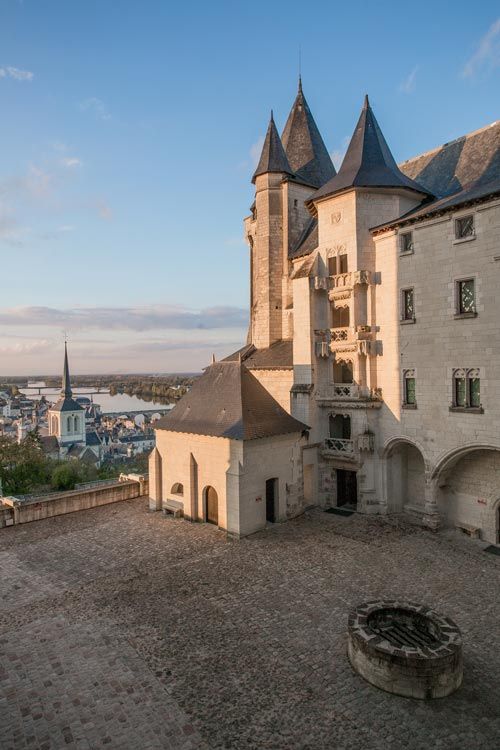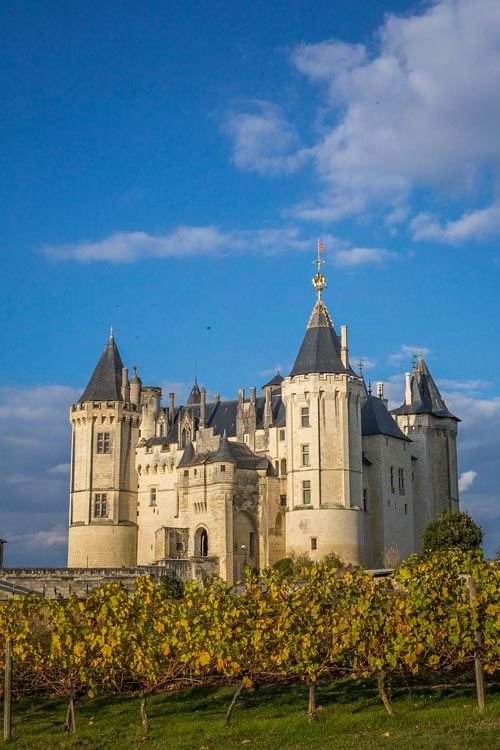"This website uses cookies to improve your user experience. Please indicate if you accept their installation on your browser."
HISTORY
It was owned by the counts of Anjou then the House of Plantagenet before being turned into a royal fortress in the early 13th century during the reign of King Louis IX. Duke Louis I of Anjou (King Charles V's brother) turned it into an opulent palace during the second half of the 14th century. The miniature of it in the famous Très Riches Heures du Duc de Berry gives us a very clear image.
King René, the last Duke of Anjou, lived here on and off. The château returned to the royal estate upon his death in 1480.
The building was used as a residence for the town's governors until the end of the Ancien Régime. The most famous of them, Philippe Duplessis-Mornay, was made governor in 1589. The town of Saumur had just been assigned to the protestant party as a safe haven. The new governor had the château fortified with the outer wall you can still see today. It was a pioneering structure at the time with the section facing the town built almost a hundred years before Vauban's masterpieces!
Château de Saumur was used as a prison between the 17th and 18th century: objectors to the regime who were imprisoned without trial then war prisoners from the 1780s onwards (mainly British sailors).


The building was spared by the French Revolution. It was in such a poor state that it was due to be demolished but Napoleon I saved it to turn it into a state prison.
Extensive work was conducted to adapt it to its future function. But the political change brought about by the restoration of the monarchy changed its fate again. It was assigned to the War Ministry in 1814 and used to store weapons and munitions.
Extensive work was conducted to adapt it to its future function. But the political change brought about by the restoration of the monarchy changed its fate again. It was assigned to the War Ministry in 1814 and used to store weapons and munitions.
The soldiers left in 1889. The Council began discussions with the government to buy the château to turn it into a museum. The purchase went through in 1906. The landmark's restoration began right away.
The partly restored landmark was opened to the general public in 1912. The council museum was set up on the first floor in the north wing with the horse museum (association museum) on the second floor.
The collections grew and the Council had to have the east wing restored to accommodate them between the wars. The château was bombed in 1940 and extensively damaged. It was repaired a few years later.
The exterior of the south wing and west tower were restored between 1997 and 2001.
Part of the northern rampart collapsed in 2001. Restoration work on it began in 2004 and ended at the end of 2007.
Château de Saumur was listed as a Monument Historique in 1862. Restoration work has been conducted with government departments since then.
Château de Saumur is part of the Châteaux de la Loire network and Roi René network.






Esplanade Hubert Landais
49400 Saumur
+33 (0)2 41 40 24 40

GPS coordinates: WGS 84
By car :
- Paris - Saumur (A10, A85, D347 and D947) :
321km (~3.5 hrs) - Angers - Saumur (A85, N147 or D952) :
55km (40 à 50 mins) - Tours - Saumur (A85, N152) :
65km (1 hr)
By train :
- Paris - Saumur : 2.5 hrs
- Angers - Saumur : 20 mins
- Tours - Saumur : 40 mins







